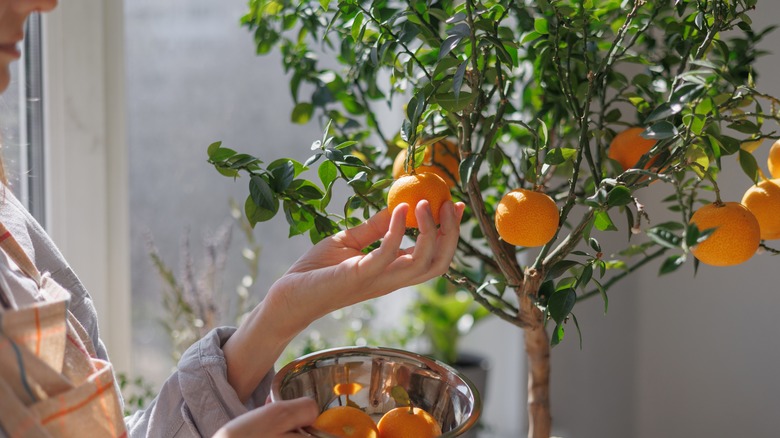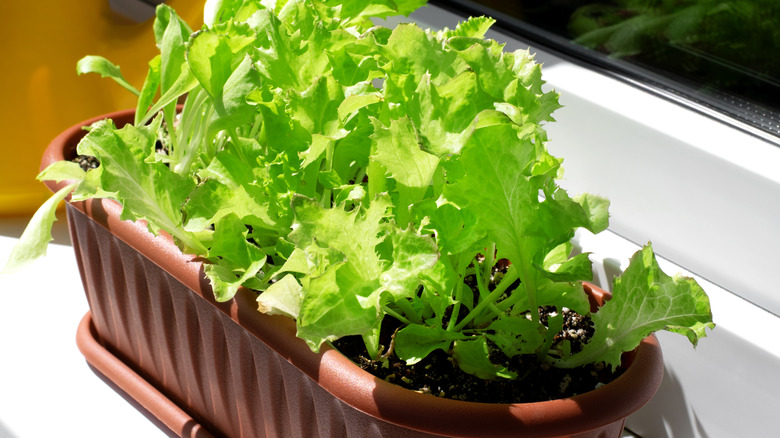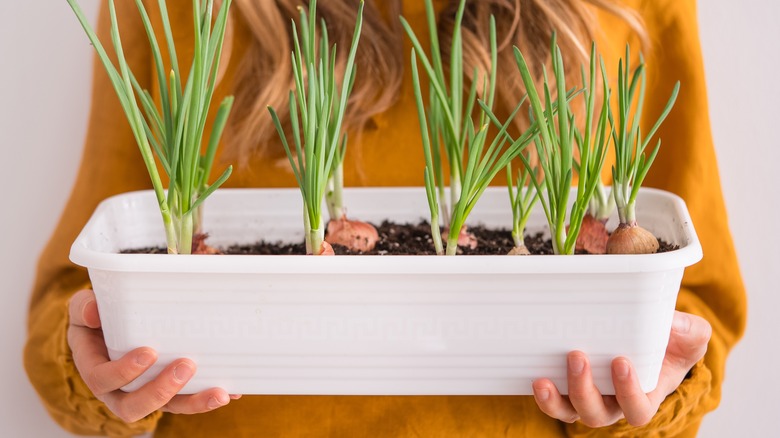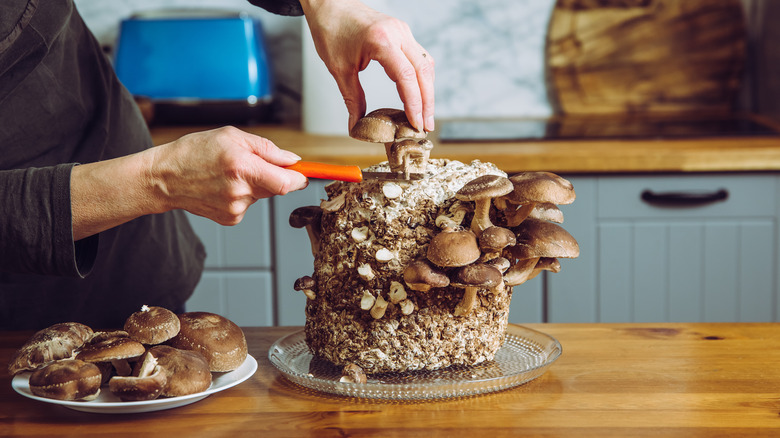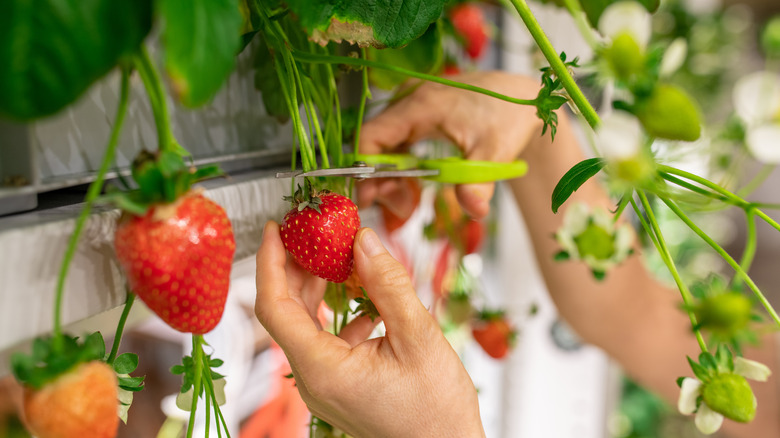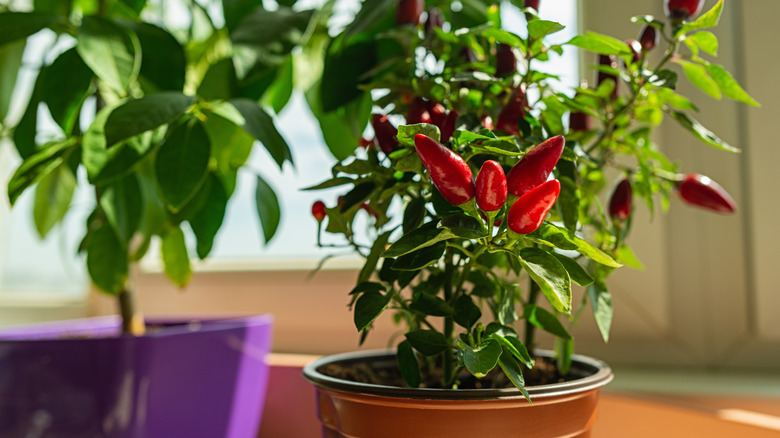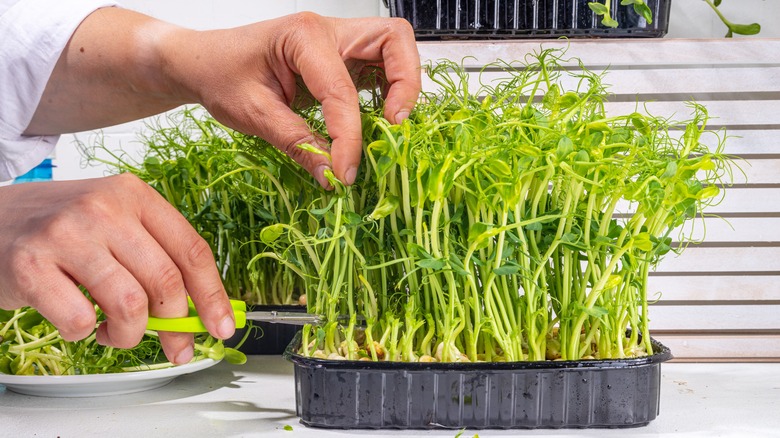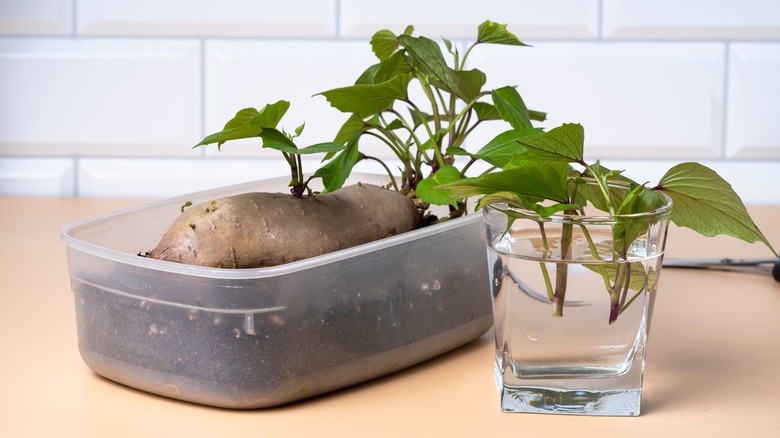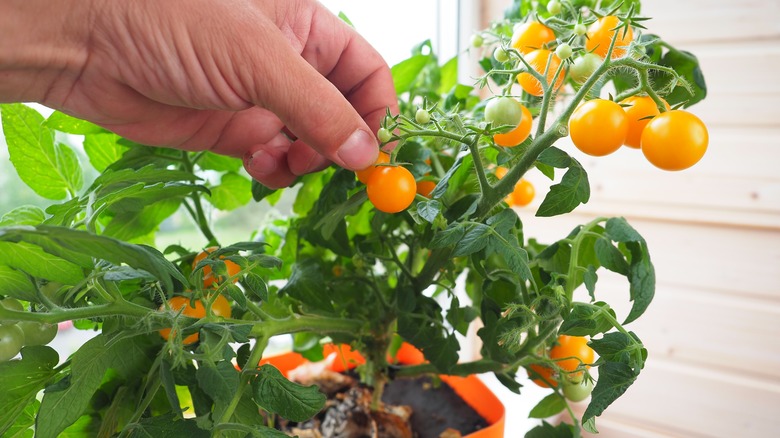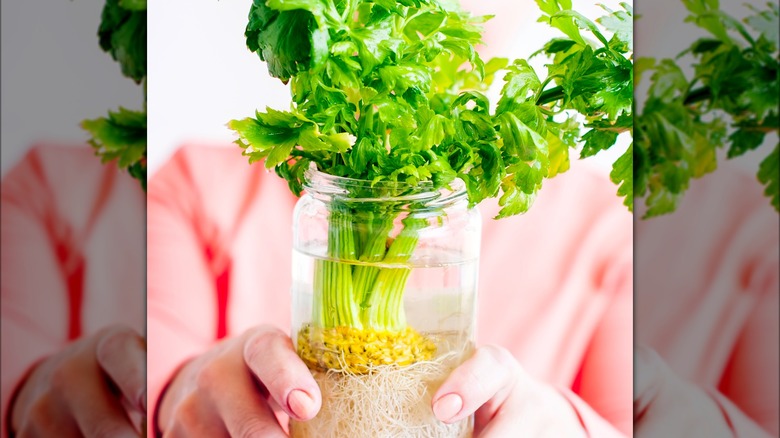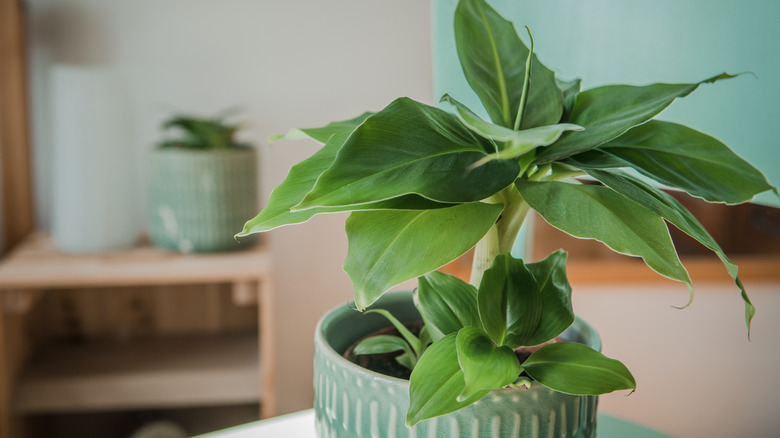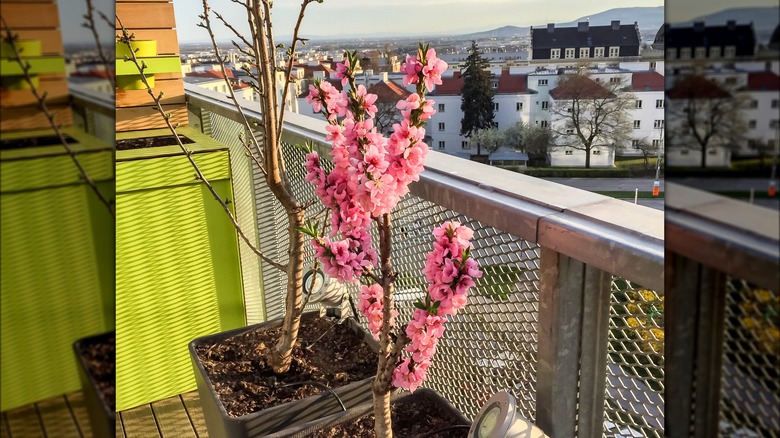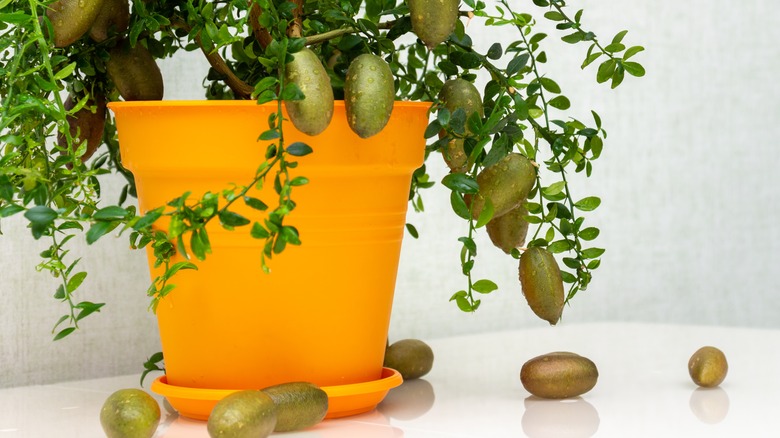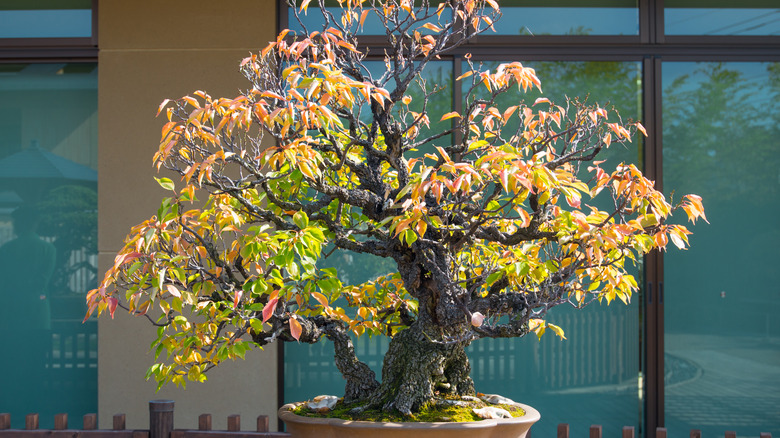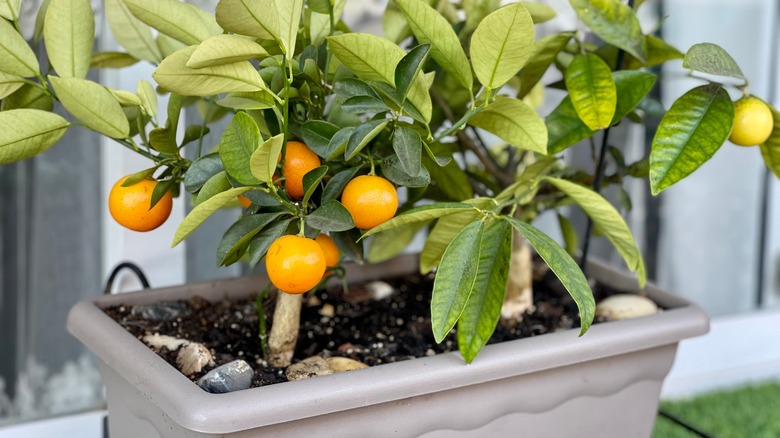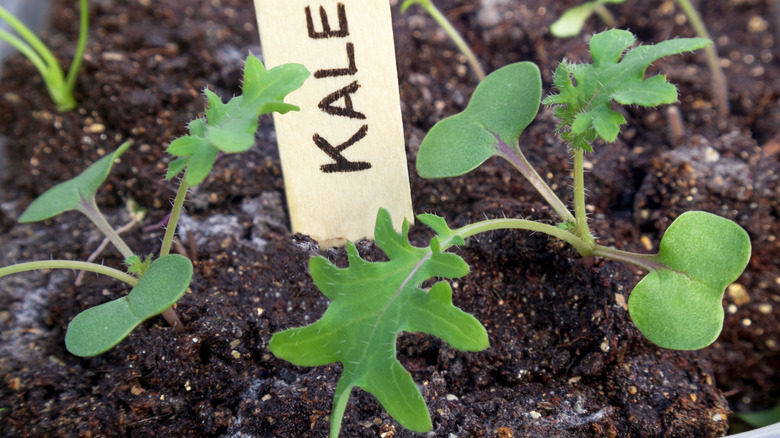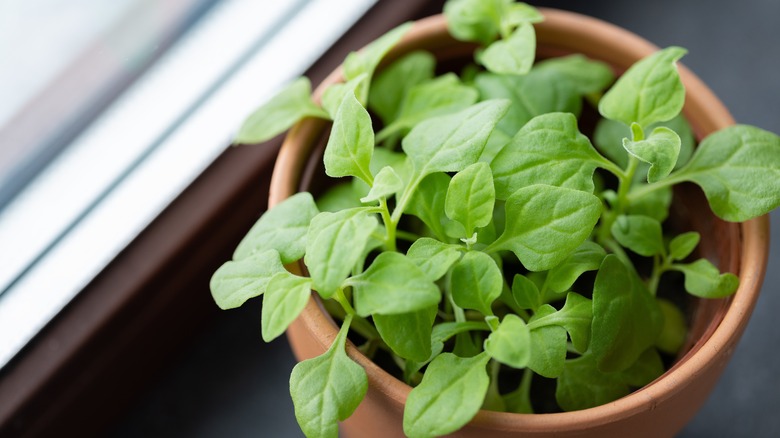The Fruits And Veggies You Can Grow In A House Or Apartment
Gardening is more than a hobby, as it's also a way to connect with nature and grow your own food source. Yet, if you lack a large outdoor space, you may think you're unable to grow anything of substance. Fortunately, that's not true, as there are many fruits and vegetables you can grow inside a house or apartment. In fact, with the right lighting, you can cultivate a thriving indoor mini-garden. To give you some ideas on what to grow, we've listed 16 edible plants that can be grown inside your home.
There are many small crops like mushrooms, spring onions, microgreens, and spinach that will thrive in a small space with adequate care. Thankfully, maintaining most of these plants is simple even for novice gardeners. On the other hand, gardeners with green thumbs looking for a rewarding challenge should also consider one of the many dwarf types of popular fruit trees. Dwarf cultivars are smaller, more compact variations of large trees. When confined to a container, these trees not only provide delicious and fresh produce, but they also bring color to a space like living decor. Keep in mind that you may need to try to hand pollinate some of these trees to see fruit.
1. Lettuce
If you want to plant lettuce (Lactuca sativa), you are spoiled for choice as there are many varieties, most of which are very forgiving and easy to grow indoors. Lettuce varieties fall into one of four categories: butterhead, crisphead, loose-leaf, and romaine. Grow your lettuce on a windowsill and in a container with moist, well-draining, and loamy soil with a slightly-acidic or neutral pH. Lettuce typically grows up to a foot tall and wide but can be stunted by a container.
2. Spring onions
Also called scallions and green onions, spring onions (Allium fistulosum) are packed with flavor. They're so easy to grow that you can even propagate a new crop from scraps. Put a cut spring onion in a jar of water and allow it to grow roots, then transfer it to a container with sandy or loamy soil and place it in a sunny spot. If left to grow to its full potential, scallions can reach up to 3 feet tall and 2 feet wide.
3. Mushrooms
There are so many species of mushrooms and most of them can be grown in a house or apartment. Because mushrooms thrive in moist, darker areas, they're often grown in indoor lab-style farms. You can mimic a similar environment in a bucket with wood chips, on a log, or with a premade kit. Mushrooms grow best in the shade, so keep them out of the sun. Depending on the type, they can grow anywhere between 2 and 12 inches tall.
4. Strawberries
Indoor strawberry (Fragaria ananassa) kits are often sold in the spring because the fruit grows well indoors. Choose one of the many cultivars like the quick-blooming 'Earligrow' and plant the seeds in moist, well-draining acidic soil. Place the container near a window where it will receive at least 10 hours of direct sunlight. Strawberry plants grow between 6 and 12 inches tall and benefit from trellises as they get taller.
5. Chili peppers
Do you like a kick in your food? Then grow the heat yourself. Chili pepper plants (Capsicum annuum) are a breeze to grow in a small indoor space. You can grow a milder type like the anaheim pepper or, if you're a spice fiend, the extremely hot ghost pepper. Grow peppers in sandy or loamy soil that has a neutral pH. Though the size is dependent on the species, some cultivars can grow a few feet tall in a container. Just remember to wear gloves when harvesting and avoid touching your eyes.
6. Microgreens
Pump up those salads and add a variety of nutrients to your diet by growing microgreens. Microgreens is really an umbrella term for a variety of leafy dwarf species of vegetables like broccoli, swiss chard, cauliflower, radishes, and arugula. They're quick to sprout and easy to harvest. Most microgreen seeds come in a mix so you'll likely grow multiple species at once. The proper way to grow and care for your microgreens varies depending on the mix, but most types thrive in small containers that receive full sun and routine watering. Many people choose to grow their microgreens in plastic takeout containers for a mini-greenhouse effect.
7. Sweet potatoes
Sweet potatoes (Ipomoea batatas) do well indoors, just like their less-sweet cousins. Because they are root vegetables, potatoes need a deeper container than other plants on this list. Many people choose to grow indoor potatoes in 10-gallon buckets or fabric grow bags. They grow best in sandy, well-draining, acidic soil and areas that receive full sun and partial shade. Potatoes can grow anywhere from 2 to 20 feet long but will be stunted by a container.
8. Cherry tomatoes
Like strawberries, cherry tomatoes (Solanum lycopersicum var. cerasiforme) are often sold in kits specifically designed to go on your windowsill. They're a compact or dwarf tomato type, but don't let that fool you into thinking their flavor is any less robust than larger options. Plant cherry tomatoes in loamy and well-draining acidic soil and place them where they'll receive 4 to 6 hours of direct sunlight a day. Water them thoroughly once a week. Thriving cherry tomato plants can grow up to 8 feet tall and 3 feet wide and will need trellising.
9. Celery
Similarly to spring onions, celery (Apium graveolens) will also grow from food scraps. Place the base in water and new leafy stalks will begin to grow. Then, you can transplant them to a container and place them where they will receive at least six hours of direct sunlight. Growing celery from a base leads to quicker yields for this typically slow-growing vegetable. Celery is best grown in moist, well-draining soil with a slightly-acidic or neutral pH. This vegetable is a great choice for small spaces as it typically only grows up to 2 feet tall.
10. Bananas
At first, you may think the home is no place for a banana tree (Musa spp.), but there are multiple dwarf species under 10 feet tall that you can grow indoors. For instance, the dwarf cavendish banana tree is a popular type that produces compact bananas. It's slow-growing though, so don't expect any fruits right away. It'll take up to 15 months to grow flowers and potentially another six to produce fruits. Banana trees grow best in loamy, moist, acidic soil and direct sunlight.
11. Peaches
Peach trees (Prunus persica) also come in multiple dwarf cultivars that will thrive in your home or on your patio. Growing dwarf peach trees won't just give you delicious stone fruits, as you'll also be able to enjoy the vivid pink flowers that bloom first. Plant them in well-draining, sandy, and acidic soil. Keep them in a container near a direct light source like an unobstructed window and they can grow up to 10 feet tall.
12. Limes
The smaller lime tree (Citrus × latifolia) cultivars may look different than their larger counterparts, but they're equally delicious and refreshing. Australian finger lime trees produce more oblong limes and can easily be grown inside. Other cultivars can grow up to 25 feet tall, while this dwarf species remains under 10 feet tall. Keep lime cultivars in loamy and moist soil with an acidic or neutral pH. Place them where they'll receive plenty of direct sunlight.
13. Apricots
Growing juicy apricots (Prunus armeniaca) indoors is quite easy when you select a miniature cultivar that is less than 8 feet tall. Just like with other types of fruit trees, you'll be able to enjoy both the gorgeous flowers and the delicious produce this tree grows. Plant apricots in sandy or loamy soil that's slightly-acidic. Ensure any cultivar you grow has access to direct sun and good airflow and you'll hopefully receive quite the bounty.
14. Oranges
Satsumas (Citrus reticulata 'Satsuma') are a small orange tree type that grows and looks delightful in a container. When outdoors, they grow best in climates with cool winters and hot summers. Inside, the tree should be placed near the window that receives the most sun. Satsumas thrive in moist and well-draining soil with a neutral or slightly-acidic pH. While these trees can reach up to 20 feet tall, their size can be controlled by a container.
15. Kale
Vitamin-rich kale (Brassica oleracea) thrives on a sunny windowsill. Alternatively, you can also grow them under grow lights should you lack a window with direct sunlight. Consider adding a humidity dome to create a warm and moist environment. Kale also needs loamy and moist soil with an acidic pH. Like lettuce, kale will grow up to 2 feet tall and wide. However, it is easily grown in a container for a smaller plant.
16. Spinach
Spinach (Spinacia oleracea) is another leafy green that you can cultivate inside. Though many plants grow better when started from seedlings or propagated, spinach grows best from seed. Depending on your region's temperatures, you may want to use a heat mat during the winter. However, be careful not to use one for too long as spinach does not respond well to high heat. Spinach will grow best in full sun as well as loamy and moist soil. As it remains less than 12 inches tall and wide, spinach is a great candidate for a perfect indoor garden.

